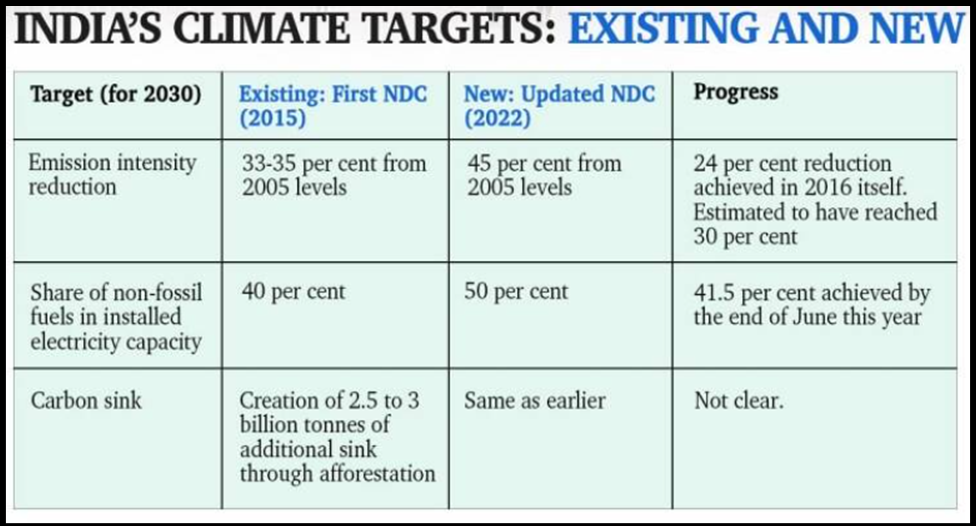Indian Economy
Karnataka Tops at Clean Energy Transition
- 01 Mar 2023
- 6 min read
Prelims: Karnataka Tops at Clean Energy Transition, Clean Energy Transition, Renewable Energy, GDP.
Mains: Clean Energy Transition.
Why in News?
According to a report from Institute for Energy Economics and Financial Analysis (IEEFA) and Ember, Karnataka and Gujarat have emerged as India’s frontrunners in the transition to clean electricity.
- Ember is an independent, not-for-profit climate and energy think tank while the IEEFA examines issues related to energy markets, trends, and policies.
What are the Highlights of the Report?
- Methodology of Assessment:
- The report ‘Indian States’ Energy Transition’ prepared a scoring system for 16 States (account for 90% of electricity production in India), and their performances are assessed on four broad parameters namely:
- Decarbonisation
- Performance of the Power System
- Readiness of the Power ecosystem
- Policies and Political commitments
- The report ‘Indian States’ Energy Transition’ prepared a scoring system for 16 States (account for 90% of electricity production in India), and their performances are assessed on four broad parameters namely:
- Assessment:
- Karnataka is the only state among the 16 analysed that scored well across all four dimensions of clean electricity transition.
- The State also exceeded its target of segregating feeders by 16% and achieved 100% of its target of installing smart meters.
- Gujarat was a little behind Karnataka in terms of decarbonising its electricity sector. Haryana and Punjab have shown promising preparations and implementations for electricity transition
- States like West Bengal, Bihar and UP are lagging far behind in the field.
- West Bengal scored low across all the parameters and its outstanding payments to generators have increased by 500% from March 2018 to March 2022.
- Rajasthan and Tamil Nadu need to improve their power system readiness.
- Karnataka is the only state among the 16 analysed that scored well across all four dimensions of clean electricity transition.
- Suggestions:
- Apart from boosting renewable energy capacity and storage, it is suggested that states take a multi-dimensional approach towards clean electricity transition, which includes efforts on the demand side.
- Innovative bilateral financial markets mechanisms like virtual power purchase agreements (VPPAs) and contracts for difference (CfD) have huge potential to open up the market and give buyers and regulators the required assurance on handling intermittent renewable energy generation.
- To monitor progress effectively and course correct when necessary, it called for data availability and transparency improvement.
What is India’s Clean Energy Target?
- As part of its international obligations, India has committed to generating about half of its electricity from non-fossil fuel sources and reducing the emissions intensity of its Gross Domestic Product (GDP) by 45% by 2030.
- Achieving this is predicated on States tweaking their infrastructure, used to deliver electricity, to efficiently accommodate inputs from multiple power sources such as solar, wind, hydropower as well as existing fossil fuel sources.
- India’s revised Nationally Determined Contribution (NDC) targets have put the country on the right path for transitioning its electricity sector.
What are the Efforts in Clean Energy Transition?
UPSC Civil Services Examination Previous Year Question (PYQ)
Prelims
Q. The term ‘Intended Nationally Determined Contributions’ is sometimes seen in the news in the context of (2016)
(a) pledges made by the European countries to rehabilitate refugees from the war-affected Middle East
(b) plan of action outlined by the countries of the world to combat climate change
(c) capital contributed by the member countries in the establishment of the Asian Infrastructure Investment Bank
(d) plan of action outlined by the countries of the world regarding Sustainable Development Goals
Ans: (b)
Exp:
- Intended Nationally Determined Contributions is the term used under the UNFCCC for reductions in greenhouse gas emissions in all countries that signed the Paris Agreement.
- At COP 21 countries across the globe publicly outlined the actions they intended to take under the international agreement. The contributions are in the direction to achieve the long-term goal of the Paris Agreement; “to hold the increase in global average temperature to well below 2°C to pursue efforts to limit the increase to 1.5°C, and to achieve net zero emissions in the second half of this century.” Therefore, option (b) is the correct answer.
Mains
Q. Explain the purpose of the Green Grid Initiative launched at World Leaders Summit of the COP26 UN Climate Change Conference in Glasgow in November, 2021. When was this idea first floated in the International Solar Alliance (ISA)? (2021)






